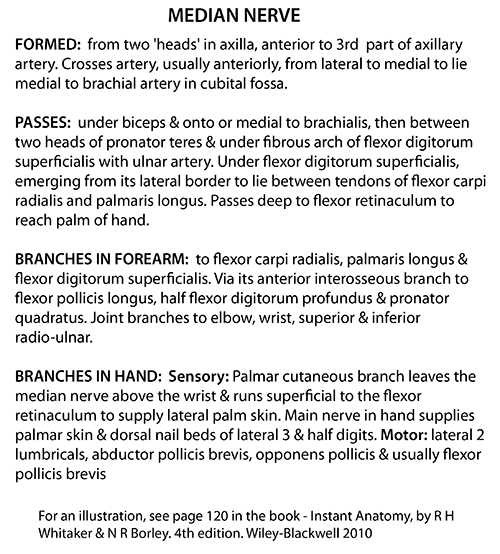MEDIAN NERVE
- MEDIAN NERVE
- ORIGIN AND ROOT VALUE
- formed by two heads in axilla
- COURSE
- AXILLA
- lies anterior to 3rd part of axillary artery ( काँख धमनी के सामने )
- crosses artery from lateral to medial (
- ARM
- enters arm from axilla at inferior border of teres major muscle
- passes vertically downwards and
- courses lateral to brachial artery ( पार्श्व स्थान पर जाता हैं_ )
- between
- biceps brachii above
- brachialis below
- then it crosses
- anteriorly to run medial to brachial artery ( फिर भुज धमनी के मध्य स्थान पर जाता हैं
- in cubital fossa
- lies medial to brachial artery
- passes under biceps
- on to or medial to brachialis
- gives articular branch to elbow
- in Forearm
- then between two heads of pronator teres
- crosses ulnar artery
- separated by the deep head of pronator teres
- then travels between
- flexor digitorum superficialis above
- flexor digitorum profundus below
- then above 5cm above flexor retinaculum
- merges between
- the flexor digitorum superficialis (medially)
- the flexor carpi radialis (laterally)
- branches in forearm
- supplies anterior compartment of forearm except
- flexor carpi ulnaris
- muscular branches
- anterior interosseus branches
- in hand
- Injury
- Injury of median nerve at different levels causes different syndromes with varying motor and sensory deficits.
- At the shoulder
- Injury can occur at the brachial plexus[9]
- Above the elbow
- Common mechanism of injury: a supracondylar humerus fracture
- Motor deficit:
- Loss of pronation of forearm, weakness in flexion of the hand at the wrist, loss of flexion of radial half of digits and thumb, loss of abduction and opposition of thumb.
- Presence of benediction sign when attempting to form a fist, due to loss of flexion of radial half of digits
- Sensory deficit: loss of sensation in lateral 3+1⁄2 digits including their nail beds, and the thenar area
- At the elbow
- Entrapment at the level of the elbow or the proximal forearm could be due to the pronator teres syndrome.
- Within the proximal forearm: anterior interosseous syndrome
- Injury to the anterior interosseous branch in the forearm causes the anterior interosseous syndrome
- Common mechanisms: tight cast, forearm bone fracture
- Motor deficit: loss of pronation of forearm, loss of flexion of radial half of digits and thumb
- Sensory deficit: none
- At the wrist
- Common mechanism: wrist laceration
- Motor deficit:
- Weakness in flexion of radial half of digits and thumb, loss of abduction and opposition of thumb
- Presence of a benediction sign when attempting to form a fist, due to weakness in flexion of radial half of digits
- Sensory deficit: loss of sensation in lateral 3+1⁄2 digits including their nail beds, and the thenar area
- Within the wrist: carpal tunnel syndrome
- Motor deficit:
- Weakness in flexion of radial half of digits and thumb, weakness in abduction and opposition of thumb
- Sensory deficit: numbness and tingling in lateral 3+1⁄2 digits including their nail beds, but excluding the thenar eminence which is supplied by the palmar cutaneous branch of the median nerve[10] Unlike in wrist laceration, sensation still occurs in the area of the central palm. Sensation is not lost because the palmar cutaneous branch runs above the flexor retinaculum, and is not affected in compression in carpal tunnel syndrome.


Discussion